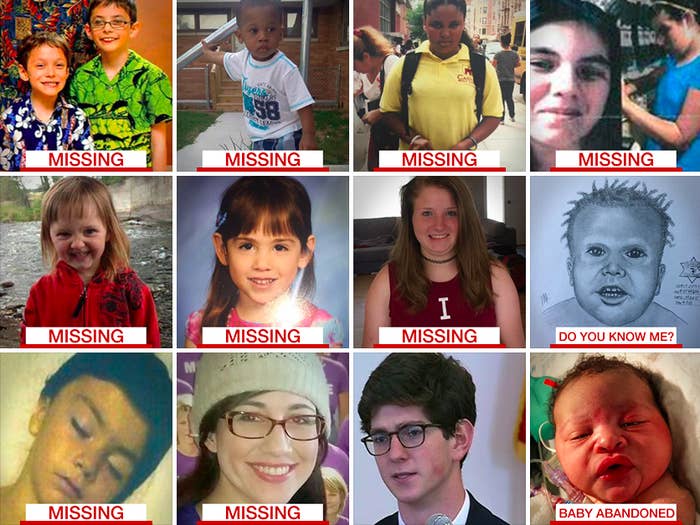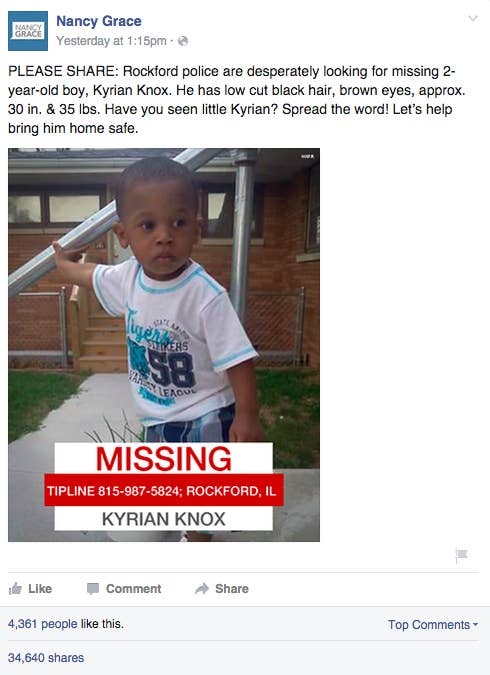
On June 18th, 2014, just before leaving the house for an evening shift at the Tiger Truck Stop near Baton Rouge, Fawn Domingue killed some time by scrolling through the Facebook page of TV’s most controversial prosecutor-turned-journalist, Nancy Grace. She watched a few videos — one of a pretty, dark-haired 16-year-old girl who’d gone missing in Florida — and rifled through some pictures, many of them grainy photos of missing children and terrifying mugshots of their alleged captors. Then she went to work. A few hours later, around 9:40 P.M., Domingue was behind the register when a newly familiar face passed through the door: the 16-year-old abductee she'd seen on Grace’s Facebook page earlier that evening.
Domingue alerted the authorities. After a police chase that lasted many miles, a 41-year-old sex offender named Steven Patrick Myers was in police custody and his abductee, Ashley Lyon, was safe, liberated by serendipity and a peculiar new breed of social content: the viral milk carton kid.
Grace’s missing persons pictures and videos are the product of a concerted newsgathering effort on the part of Grace’s team at HLN, one that’s done with the help of the increasingly popular newsroom tool, Crowdtangle. It works like this: Crowdtangle tracks and monitors millions of posts and keywords across social media platforms — with an emphasis on Facebook — in order to identify topics and individual Facebook posts that are performing better than average for a page or individual. In HLN’s case, Grace’s reporters, producers, and social media managers plug in a series of topics and keywords to Crowdtangle, taking pains to look for stories from a massive list of local news affiliate Facebook pages — for Nancy Grace’s page, this means a focus on abductions, abandoned children, stalkers, rapists, serial killers, and grisly domestic crime. Then, Crowdtangle scans the social web, sending alerts to the team if it finds a story that’s compelling high rates of Facebook sharing.
“If we see something really over-performing at a local level, that’s usually a good indicator there’s national interest,” HLN’s Senior Director of Social Media Strategy and News, Katie Caperton, told BuzzFeed News. “I can see that this kid's gone missing and that every affiliate who also posts about this missing child is seeing 20-40 times the average engagement. We choose to create our own content around the story if we believe we’ll get that engagement from our followers on the national level as well.”
The strategy translates to on-air stories as well, Caperton said. “The Nancy Grace digital and social producers send 10 stories a day to executive producer of the show, saying, ‘This is really over-performing in Alabama or Portland, let’s take a deeper look at this now.’”

When the team decides to pick up on a missing persons story, they create a milk carton-style graphic — a picture of the person adorned with information like a tipline number and the location the person was last seen. The graphic is typically shared with the caption: “PLEASE SHARE:” and a more detailed description; the graphic often ends with a hopeful missive to encourage more sharing like, “spread the word! Let’s help bring him home safe.”
It works. As of last July, an HLN representative told BuzzFeed News that Grace’s Facebook page had an astounding average of 22,000 shares per post, which can easily translate to millions of views across the platform. A recent “abandoned baby” graphic racked up 2,389 likes and 3,102 shares in just 36 minutes.
That kind of engagement is the envy of newsrooms across the country. And even though Caperton insisted that the posts are more of a public service — “we just want to get these things out quickly” — than a traffic driver, the deeply viral nature of them undoubtedly help promote the Nancy Grace and HLN brands. The more you think about it, the more it looks like Caperton and her team are looking for #TheDress of missing kids, and the more uncomfortable the line between exploitative and altruistic becomes.
It’s a line Caperton and HLN have considered at great length. “I think if it was your child, sister, or mom who was missing, you wouldn't feel exploited by this,” Caperton said. “You'd want it amplified and you'd want as many people to know as possible.” Still, Grace’s team will have a hard time getting the benefit of a doubt. She and her show remain controversial among detractors who’ve accused her and her program of exploiting particularly heinous crimes for ratings. On the web, Grace’s history is particularly fraught, driven in part by her incessant use of hashtags that are so callous and blunt, they’re basically comic performance art.
The issue here is when you have a child & then try to murder it #BabyInDryer
The use of a tool like Crowdtangle and the introduction of algorithmically driven newsgathering ultimately allows the newsroom to have more eyes on more stories — but there’s a hidden cost. Algorithms, by nature, discriminate, and the un-democratic process of going viral means that while a select few are given a loud megaphone, others are largely ignored. Regardless of the diversity of the victims that make up Grace’s milk carton collection, the truth remains that the HLN team is picking real humans in the somewhat troubling hope that their tragedy might resonate enough with a national audience to share widely on Facebook. When asked about the stories that tend to “over-perform,” Caperton noted that stories about missing children and abducted women walking home from work at night tend to resonate with readers because they elicit a near-universal emotional response. “These are the kinds of stories where people really feel for the victims and think, 'gosh, what would I do if this was happening to me?'”
Inside the comments section there’s a kind of catharsis at play. Many commenters appear to grieve in the posts, offering their prayers, or providing a personal anecdote. While some are combative or patronizing, often the posts elicit a stream of distraught and impassioned people determined to help wide the net of the search, saying things like “I’ll share~always do” or “shared in Jackson Michigan,” in order to let others know the news has made it to their region. Caperton sees this as the most important element of the team’s work and a critical part of the success of the viral milk carton posts. “I think many people feel that, at the end of the day, if you have done nothing else but share an image of a missing child for the people on your feed, you've done something and maybe had a hand justice in a small way,” she said. “Ultimately it’s about people who’re trying to do their part to help others in some small way.”
Again, it’s murky territory. The tools that decentralize this type of newsgathering also complicate it. But what can be cast in one light as armchair activism, can also mean saving real lives -- just ask Ashley Lyon.
